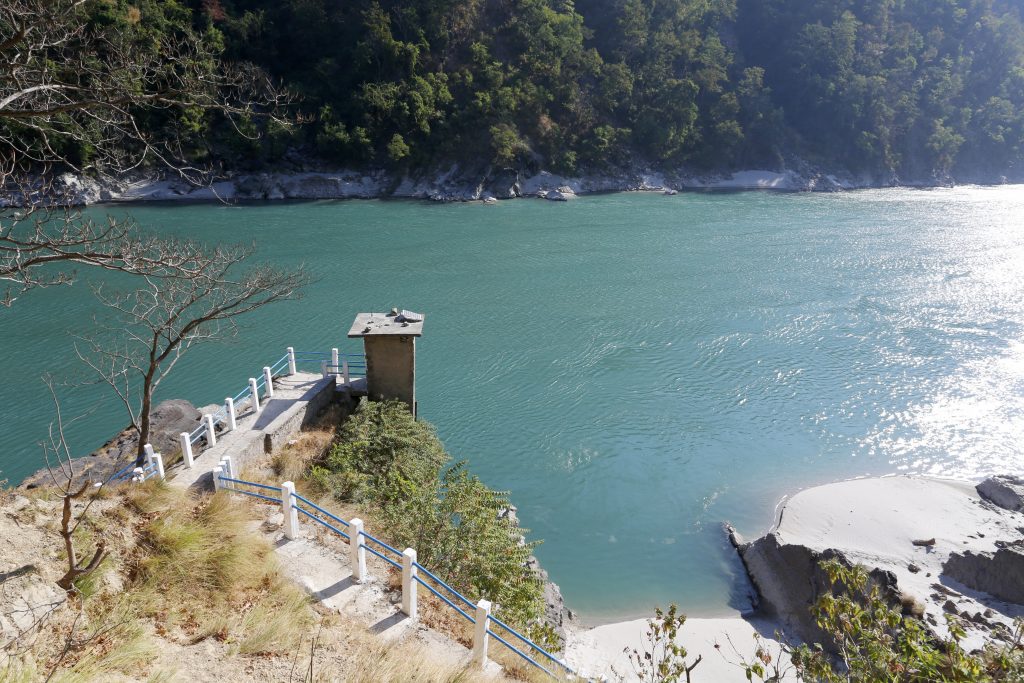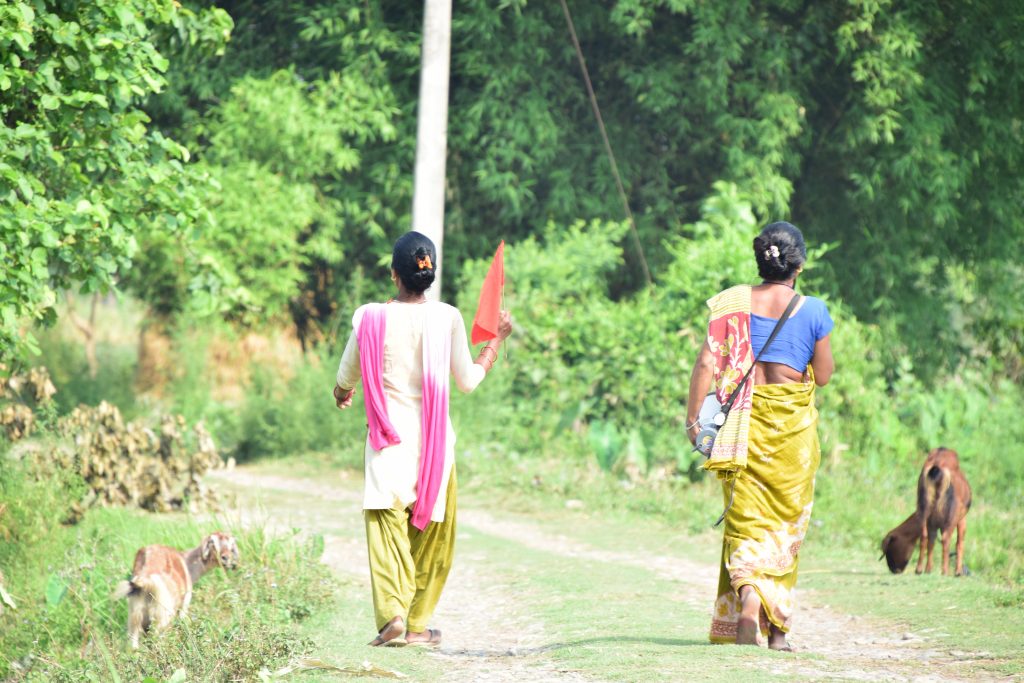For their MSc consultancy project last year, LSE International Development candidates Georgia Alexiou, Sara Cucaro, Lauren Goodwillie and Kinya Mugaine undertook research in partnership with Mirianna Budimir and Anna Svensson of Practical Action on how early warning systems can be improved for communities in remote, mountainous areas.
In the post below, the authors share the findings of their research on the various challenges that impede early warning systems in these areas, such as mobile connectivity and energy access, and highlight potential solutions.
Early Warning Systems can be effective for saving lives ahead of natural hazard events. The earlier a person is warned of a hazard, and the more prepared they are, the more time they have to make critical life-saving decisions.
Early warning systems: dependency on mobile connectivity and energy
Many aspects of early warning systems, from the technologies used for monitoring and forecasting to the channels used to communicate data and disseminate alerts rely on mobile connectivity and energy sources. In places where such access is limited, this causes huge challenges.

Practical Action, a development organisation with decades of experience developing early warning systems, and a group of master’s students from The London School of Economics and Political Science (LSE) have collaborated on research that explores challenges, barriers, and potential solutions for early warning systems that operate in mountainous, remote environments with often unreliable mobile connectivity and energy access. The resulting report is based on case study research on the Mountainous regions of Peru and Nepal.
Nepal is the second most mountainous country in the world and experiences a variety of related natural hazard events, including avalanches, earthquakes, droughts, floods, glacial lake outburst floods (GLOFs) and landslides. Similarly, Peru is highly exposed to disaster risks caused by natural hazards; between 2003 and 2015, Peru experienced more than 50,000 disasters that caused 2,125 deaths and affected more than 12 million people. Mountain regions face multiple natural hazards, including those related to climate change. Some hazards only occur in mountainous areas or hit the areas harder and more frequently than in plains.
Mountainous regions with disproportionately low access to energy and mobile connections
While access to energy sources and mobile connectivity is increasing around the world, remote and mountainous regions still have disproportionately less access to reliable energy sources and connectivity to mobile phone infrastructure.
Most remote mountainous regions in ‘developing countries’ have disrupted, fragile, or poor-quality energy sources, often due to infrastructural gaps such as lack of power grid supply capacity, lack of funding, restrictive regulations, and topographical challenges such as difficult terrains. The lack of reliable energy sources subsequently affects the connectivity of these regions to mobile networks, as well as the pertinence of mobile-enabled EWS.
These remote regions are also forced to contend with additional challenges related to the digital divide, which manifests through unequal access to digital technologies and a lack of skills/literacy (general or technological).
Unreliable energy access and mobile connectivity puts people at risk of disasters
These challenges mean that people living in rural mountainous areas are at an information access disadvantage in the event of a disaster, with potentially dire consequences.
Inadequate energy and mobile connectivity impact the effectiveness of an early warning system by disrupting continuous monitoring and systematic data collection and therefore forecasting capabilities, as well as impairing dissemination and communication of early warning messages.
This has a domino effect on the system, resulting in people either receiving inaccurate warning information, warnings that are too late, and/or no warning at all. These scenarios all result in decreased local capabilities to act in time and prevent an impending disaster.
Developing resilient alternatives
The picture painted above makes a clear case for investing in more reliable energy access and communication options in these regions.
While diesel and gasoline generators can be effective for providing energy access, long-term sustainable solutions need to use hybrid energy systems that incorporate renewable sources. These may include off-grid renewable energy systems, solar panels, and hydropower. Additionally, batteries and inverters can be incorporated in hybrid energy systems to mitigate supply intermittency issues.

Both technological and non-technological approaches can be utilised to address mobile connectivity issues. Layering dissemination methods and building redundancies into the system is crucial to communicate risk to as many people as possible before a disaster occurs.
More traditional methods include radio transmission, automated community display boards, and siren systems, while disruptive technologies that can support EWS include decentralising energy solutions, the adaptation of wireless technologies including satellites and the Internet of Things, artificial intelligence, and social media applications.

Disasters have a detrimental impact by damaging or destroying infrastructure including roads, cell towers, and optical fibres and cables, causing disruption to the monitoring of environmental conditions and dissemination of warnings resulting in increased vulnerability to potential future events while people are trying to recover from a previous one.

Although new technologies are being trialed regularly, local knowledge related to disaster risk is often excluded and technologies are parachuted in by outside organizations, limiting successful utilization and in some cases reinforcing hazard risks.
Therefore, whichever solutions are pursued it is vital to understand that projects that try to address issues without collaboration with local communities are likely to exacerbate challenges. Trust between development organisations and communities, and local ownership over solutions are key to success. Practical Action uses the innovative Flood Resilience Measurement for Communities to facilitate collaboration with flood prone communities.
Community members should have influence over the development, ownership, and installation of early warning systems and their components. It’s important that local people have the knowledge, training, and resources needed to use and maintain monitoring and communication devices, as well as the energy sources powering them. Ownership and responsibility for the maintenance of all aspects of these systems need to be agreed with the local community.
![Members of a local disaster risk reduction network with their solar powered early warning monitoring device [https://practicalaction.org/knowledge-centre/resources/monitoring-rainfall-for-early-warning-perus-ingenious-solutions/] near Lima, Peru. Photo by Practical Action.](https://blogsmedia.lse.ac.uk/blogs.dir/57/files/2022/11/EWS-Monitoring-station-with-brigades-2-Lima-Chosica-1024x683.jpg)
Changing the system to reduce the risk in hard-to-reach areas
NGOs like Practical Action, working closely with at risk communities can save lives and livelihoods in mountainous areas at risk of natural hazards. However, to sustainably reduce the risk and vulnerability of hard-to-reach communities systemic changes are needed too. Our report recommends the following from decision makers and funders:
- Expand renewable energy investments and subsidy policies to promote transition towards environmental sustainability and durable EWS.
- Encourage more bottom-up forms of cooperation between government agencies and local people, attributing higher relevance to people-centred approaches to monitoring and resilience-building.
- Design government policies, laws, and regulations to encourage investment in mobile broadband infrastructure and cross-industry collaboration to help close the coverage gap.
- Promote long-term constant and coordinated data sharing platforms for usage by NGOs, researchers, and government agencies.
- Invest in or develop partnerships with organisations optimising emerging technologies that can support EWS.
Find out more
If you’re interested in digging further into our research read Energy sources and mobile connectivity for early warning systems in remote mountainous contexts or watch a presentation from the LSE students who conducted the research. If you want to find out more about Practical Action’s work on flood early warning systems have a look at Practical Action and Early Warning Systems.
The views expressed in this post are those of the authors and do not reflect those of the International Development LSE blog or the London School of Economics and Political Science.
Main image credit: Practical Action.





